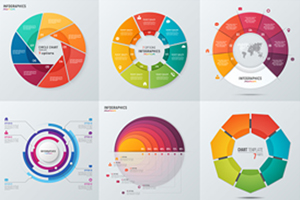
Registrars are charged with collecting information, securing it, and making it available as necessary and appropriate.
“That’s been true for centuries, but today we have more data and more tools than ever before at our fingertips,” said Carla L Boyd, Registrar at University of Minnesota Duluth.
“We play an important academic support role and can bridge the gap to reaching campus or system goals through how we present information,” said Ken Myers, Registrar and Associate Professor at University of Minnesota Crookston.
Effective data visualization helps the office of the registrar tell more powerful, accessible stories based on the data they steward. Not only does that information help students and stakeholders, but it can also demonstrate the scope of the registrar’s responsibilities beyond just registering students.
So, what’s effective?
“It’s not just pulling data; it’s selecting what pieces of the data are really needed and how to share it in the best way -- utilizing color, charts or graphs, and goal-setting,” said Myers, whose campus has found friendly competition to be effective -- setting a benchmark and having academics departments compete to reach the goal.
“For example, using Excel: for the last two semesters, we’ve had 100 percent of faculty post syllabi, a big improvement over the previous years,” Myers said. “By using conditional formatting in Excel and pre-establishing that formatting so sometimes it’s just a copy-and-paste of data-specific columns into a spreadsheet so it automatically changes the color of the cells based on department and percentage, each department is able to see exactly where they stand compared to other departments.”
“Ken has done a great job with Microsoft [Excel] pulling data in and making it visual and appealing to create data transparency and understanding,” Boyd said. “Our campus is using the Google suite to do the same thing in a different way, rolling it out in a web-based form.”
“These are free, non-technical tools provided by our system’s Microsoft and GSuite licenses that anyone can use,” she added. “In the past, we had this data but we needed tech people in order to use it, which depended on campus resources. Now there are tools and methodologies that registrars can apply, based on what we know about how people learn, and applying it to data.”
Now, instead of drowning in big data, registrars can add value to the data, focusing on necessary questions and coaching stakeholders in how to use the data. In many cases, registrars are mentoring and teaching faculty and staff how to glean, share, and use analytical data to support student success, and further the campus mission and values. Boyd and Myers have implemented training sessions for new faculty and staff, establishing the registrar’s offices as partner, as well as a knowledgeable, engaged and available resource -- not a resource “on a shelf somewhere,” Myers said.
Information is power
“We want to learn to do this well in order to to tell powerful stories that change the way we understand who we are, what we are, and why we’re doing it,” Boyd said.
Working within the UM system, Myers and Boyd have developed a synergy among offices, where they try various things at different campuses in order to learn and grow together. That kind of collaboration has been critical to their learning, and they’re bringing that spirit to the 2018 AACRAO Technology and Transfer Conference in July.
“That’s one of the things I love about AACRAO Tech,” Boyd said. “It’s a wonderful opportunity to bring theory and practice together for collaborative thinking, which can be brought back to campus to use immediately.”
Attendees at the “Data Visualization” session will come away with new skills and feel empowered to make immediate changes on their campuses.
“We’ll give more specific examples about what we’re doing and how it was implemented, which can be used or tweaked as necessary,” Myers said.
“In addition, people new to their positions can begin to get a handle on and an understanding of all the data they have,” Boyd added. “How do you take that first step? How have others taken that first step? What’s the next step after that?”